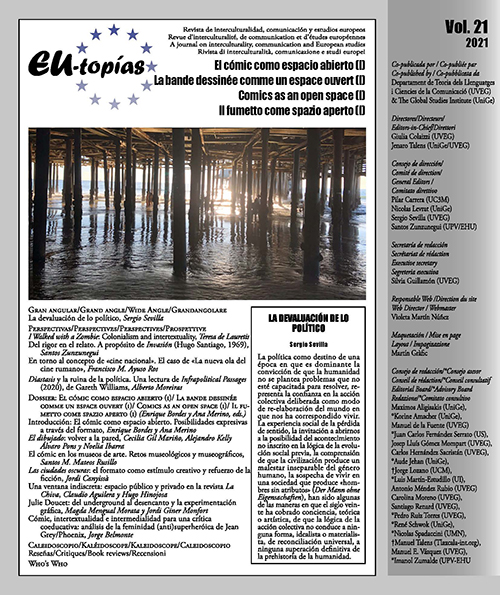Comics, intertextuality and intermediality for a coeduational critique: Analysis of the (anti)superheroic femininity of Jean Grey/Phoenix
DOI:
https://doi.org/10.7203/eutopias.21.21274Keywords:
Comic, cinema, Jean Grey/Phoenix, (anti)superheroic femininity, audiovisual coeducation. Abstract
Abstract
The mythology of the American superhero comic book figure, characterized by a global and cross-cultural circulation, expanded its original space of comic vignettes with the arrival of its plots and characters in the universe of audiovisual media, an intermedial expansion that has continued and increased significantly in the 21st century. In addition to appreciating the opening of the comic to the expressive space of other media, we will stress the necessity of such opening for the academic and educational reflective spaces, by analysing, critically and intertextually, the (anti)superheroic femininity of one of Marvel’s character with coeducational purposes: Jean Grey, a character from the long-lived X-Men comic book (Stan Lee y Jack Kirby, 1963), recently brought to the screen in in Dark Phoenix (Simon Kinberg, 2019).
 Downloads
Downloads
 References
References
Belmonte, Jorge. «Fantasías sobre feminidad, fatalidad y mutación: del cómic al imaginario de la cultura audiovisual». Dossiers Feministes, 20, 2015, pp. 141-156.
Belmonte, Jorge. «Mutantes, mutatis mutandis: de metáfora transcultural e intermedial sobre la juventud a objeto para una coeducación audiovisual». EU-topías. Revista de interculturalidad, comunicación y estudios europeos, 14, 2017, pp. 101-120.
Belmonte, Jorge. «Coeducación audiovisual, cultura mediática y crítica de la sociedad patriarcal». Educación, cultura y sociedad: espacios críticos. Coords. Miriam Abiétar, Jorge Belmonte y Elena Giménez, Valencia: Tirant lo Blanch, 2018, pp. 31-45.
Bucciferro, Claudia, ed. The X-Men films: a cultural analysis. Lanham: Rowman & Littlefield, 2016.
Burch, Noël. El tragaluz del infinito. Madrid: Cátedra, 1987.
Cocca, Carolyn. Superwomen: Gender, Power, and Representation. New York: Bloomsbury Academic, 2016.
Colaizzi, Giulia. La pasión del significante. Teoría de género y cultura visual. Biblioteca Nueva: Madrid, 2007.
Creed, Barbara. The Monstrous-Feminine: Film, Feminism, Psychoanalysis. Routledge: New York, 1993.
De Lauretis, Teresa. Alice Doesn’t: Feminism, Semiotics, Cinema. Indiana University Press: Bloomington, 1984.
De Lauretis, Teresa. Technologies of Gender: Essays on Theory, Film and Fiction. Indiana University Press: Bloomington, 1987.
Doane, Mary Ann. Femmes Fatales. New York: Routledge, 1991.
Kristeva, Julia. Poderes de la perversión. Siglo XXI: Buenos Aires, 1980.
Pedraza, Pilar. La bella, enigma y pesadilla, Barcelona: Tusquets, 1991.
Prater, Lenise. «Gender and power: The Phoenix/Jean Grey across time and media». Colloquy: Text, Theory, Critique, 24, 2012, pp. 159-170.
Talens, Jenaro. «Políticas y laberintos del imaginario. Drácula como síntoma». El cine y lo siniestro. Eds. Jesús Angel Baca y Alfonso Galindo. Almería: Diputación de Almería, 2005, pp. 122-150.
Downloads
Published
How to Cite
-
Abstract633
-
PDF (Español)479
Issue
Section
License
![]()
The authors conserve the copyright. All content published in EU-topías. Journal of interculturality, Communication, and European Studies are subject to the license Creative Commons Attribution-NonCommercial-ShareAlike 4.0 license. The full text of the license can be found at <http://creativecommons.org/licenses/by-nc-sa/4.0>
They may be copied, used, disseminated, transmitted and publicly displayed, provided that:
- The authorship and original source of the publication is cited (journal, publisher and URL of the work).
- They are not used for commercial purposes.
- The existence and specifications of this license of use are mentioned.
It is the responsibility of the authors to obtain the necessary permissions for images that are subject to copyright.



